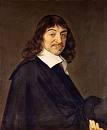1902 Encyclopedia > Algebra > History of Algebra - René Descartes (1596-1650).
Algebra
(Part 12)
(B) HISTORY OF ALGEBRA
(xi) René Descartes (1596-1650)
In tracing the history of algebra, we have seen, that in the form under which it was received from the Arabs, it was hardly distinguishable as a peculiar mode of reasoning, because of the want of a suitable notation; and that poor in its resources, its applicability was limited to the resolution of a small number of uninteresting numeral questions. We have followed it through different stages of improvement, and we are now arrived at a period when it was to acquire additional power as an instrument of analysis, and to admit of new and more extended applications. Vieta saw the great advantage that might be derived from the application of algebra to geometry. The essay he made in his theory of angular sections, and the rich mine of discovery thus opened, proved the importance of his labours. He did not fully explore it, but it has seldom happened that one man began and completed a discovery. He had, however, an able and illustrious successor in Descartes, who, employing in the study of algebra that high power of intellect with which he was endowed, not only improved it as an abstract science, but, more especially by its application to geometry, laid the foundation of the great discoveries which have since so much engaged mathematicians, and have made the last two centuries ever memorable in the history of the progress of the human mind.

René Descartes
Descartes' grand improvement was the application of algebra to the doctrine of curve lines. As in geography we refer every place on the earth's surface to the equator, and to a determine meridian, so he refereed every point of curve to some line given by position. For example, in a circle, every point in the circumference might be referred to the diameter. The perpendicular from any point in the curve, and the distance of that perpendicular from the centre or from the extremity of a diameter, were lines which, although varying with every change of position in the point from which the perpendicular was drawn, yet had a determinate relation to each other, which was the same for all points in the curve depending on its nature, and which, therefore, served as a characteristic to distinguish it from all other curves.
The relations of lines drawn in this way could be readily expressed in algebraic symbols; and the expression of this relation in general terms constituted what is called the equation of the curve.
This might serve as its definition ; and from the equation by the processes of algebra, all the properties of the curve could be investigated.
Descartes' Geometry (or, as it might have been named, the application of algebra to geometry) appeared first in 1637. This was six years after the publication of Harriot's discoveries, which was a posthumous work. Descartes availed himself of some of Harriot's view, particularly the manner of generating an equation, without acknowledgement; and on this account Dr Wallis, in his algebra, has reflected with considerable severity on the French algebraist. This spirit has engendered a corresponding eagerness in the French mathematicians to defend him. Montucla, in his history of the mathematics, has evinced a strong national prejudice in his favour; and, as usually happens, in order to exalt him, he hardly does justice to Harriot, the idol of his adversaries.
The new views which the labours of Vieta, Harriot, and Descartes opened in geometry and algebra were seized with avidity by the powerful minds of men eager in the pursuit of real knowledge. Accordingly, we find in the 17th century whole host of writers on algebra combined with geometry.
Our limits will not allow us to enter minutely into the claims which e ach has on the gratitude of posterity. Indeed, in pure algebra the new inventions were not so conspicuous as the discoveries made by its applications to geometry, and the new theories which were suggested by their union. The curious speculations of Kepler concerning the solids formed by the revolutions of curvilinear figures, the Geometry of Indivisibles by Cavalerius, the Arithmetic of Infinites of Wallis, and, above all, the Method of Fluxions of Newton, and the Differential and Integral calculus of Leibnitz, are fruits of the happy union. All these were agitated incessantly by their inventors and contemporaries; by such men as Barrow, James Gregory, Wren, Cotes, Taylor, Halley, De Miovre, Maclaurin, Stirling, and others, in t his country; and abroad by Roberval, Fermat, Huyghens, the two Bernoullis, Pascal, and many others.
Read the rest of this article:
Algebra - Table of Contents
|